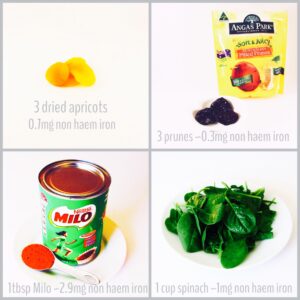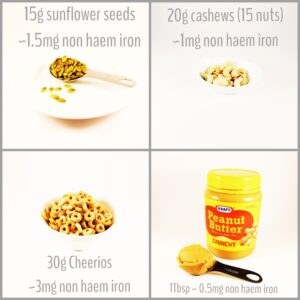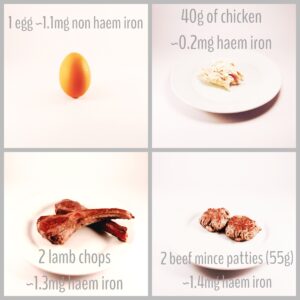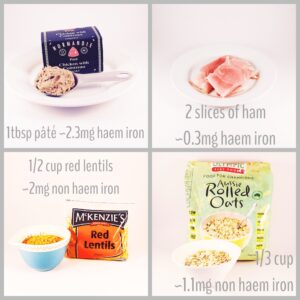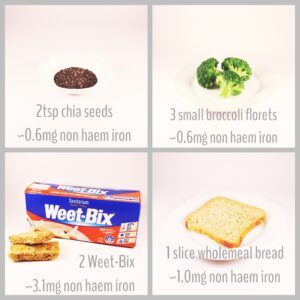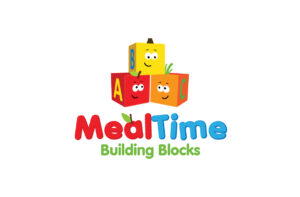
As you know, I recently wrote a blog post on chewing difficulties and fussy eaters for the lovely Kyla from Mealtime Building Blocks in Perth. And as part of our blogging exchange, she agreed to write a blog post for me. My blogging topic request? The number one concern that all my families have – iron intake. Here is what Dr Kyla Smith (Paediatric Dietitian) had to say about this tricky topic….
But first make yourself a cup of tea – it’s a long blog post but honestly the most thorough one I’ve read in a long time on the topic. I definitely learned a lot from it. Thanks Kyla!
Most of the fussy eaters I work with only eat a select number of particular foods (most often carbohydrate foods), yet they tend to be growing well. They seem to be getting enough energy (or kilojoules) from the foods they eat, and mostly they’re doing ok with nutrients too. This is often hard for parents to believe, especially when their child eats such a limited variety of foods. However, as a dietitian, the one nutrient I am usually concerned about is iron. Most fussy eaters tend to have a limited intake of foods high in iron, especially foods like red meat. So, if you’ve got a fussy eater in your family, then here’s what you need to know about iron.
Why is iron so important?
Iron has multiple jobs in the body. It has an important role in transporting oxygen to our cells, has a role in immune defense and it critical for adequate growth and brain development in children. Without enough iron kids can be tired and grumpy, have difficulty concentrating, get sick with coughs and colds regularly and have smaller appetites than normal.
How much iron do children need?
Toddlers aged 1-3 years need somewhere between 4-9mg of iron from food per day. Young children aged 4-8 years need somewhere between 4-10mg from food per day. That’s a pretty big range and it’s difficult to explain exactly how much different children need, especially when there’s no simple test to work it out for an individual child. For at least half of the population, 4mg is sufficient to meet their iron requirements. The other half of the population are likely to have slightly higher needs, somewhere between 4-10mg. For simplicity sake, let’s say on average that we’ll aim for about 7mg of iron per day.
Now I said we’d simplify it, but in fact, things get even harder from this point on. Bear with me! The amount of iron actually absorbed by the body is actually much less than the amount of iron in the food that we eat. To confuse things further, the amount of iron absorbed also differs between foods. So unfortunately it’s not quite as simple as just eating foods that contain 7mg of iron.
Understanding iron absorption
The first important factor to understand about absorption is the type of iron. There are two types- haem iron and non-haem iron.
–Haem iron is found in foods that come from animals (such as meat), and this type of iron is the most easily absorbed iron.
–Non-haem iron is found in plant-based foods, as well as being present in small amounts in meat, but is not absorbed as well as haem iron.
Research suggests that the amount of haem iron absorbed from food (animal products) is about 20% of the total iron in the food, but the amount of non-haem iron (plant foods) absorbed from food is only about 10%. This means that haem iron is twice as available for absorption as non-haem iron. Essentially, this means that you have to eat double the amount of non-haem sources (plant foods) compared to haem iron sources (animal products) to get as much total iron. Still with me?
The second important factor is the presence of iron absorption enhancers versus inhibitors, both of which can influence the amount of non-haem iron kids can absorb from food. The two best ways to enhance iron absorption are to include fruits and veggies in meals, and to also include meat in those meals. Foods rich in vitamin C (most fruits and veggies) help the body absorb more non-haem iron from foods. Meals containing meat also increase the amount of non-haem iron available to be absorbed, something known as ‘the meat effect’.
The two most common ways that iron absorption is inhibited, include when kids consume iron-rich foods with calcium-rich foods (like milk and yoghurt) or with foods that are high in naturally occurring oxalates or phytates, such as spinach and kale. Calcium, oxalates and phytates all reduce the amount of iron absorbed at the meal they are contained in. This is why spinach is often talked about as having a very high iron content, but the truth is that only the very smallest amount is actually available to be absorbed by the body.
Hopefully by this point you can see that it’s not as easy as comparing red meat (2.5mg of iron per 100g) with dried apricots (3.1mg of iron per 100g). We can’t just use the total iron levels to compare different foods because the type of iron differs (haem vs non-haem), the enhancers and inhibitors differ, and the amount of each food we actually eat differs.
So, how do we work out how to get our ‘7mg’ of iron from food? Well, the recommendations that I talked about earlier have been written to account for the amount of iron actually available for absorption. That 7mg accounts for the fact that only 10-20% is absorbed, depending on the type of iron consumed. Our national guidelines work on the assumption that about 14% of iron is absorbed from a diet containing both haem and non-haem iron sources. This means that if we aim for about 7mg from a mixed diet, we end up with about 1mg of iron actually being absorbed, which meets our body’s needs. For children who eat absolutely no meat (including very fussy kids, vegetarians and vegans), the requirements work out to be about double (around 14mg) to get this 1mg of absorbed iron, because it’s coming from mostly non-haem sources.
Throughout this post, I’ve developed some pictures to show you the iron content of different foods – scroll back and forth between the pictures to help you understand the different plant vs animal base foods and their iron levels.
Remember that we can’t just compare products based on the total amount of iron. Hopefully now you know that iron foods are NOT created equal, and that the plant-based foods have less than half the available iron of animal-based foods. We don’t know exactly how much iron we can actually absorb, and we also know that other ingredients in the meal can affect this absorption further. These pictures are meant as a guide only!
So, the take home message? Aim for a variety of foods overall, and consider offering foods that are good sources of iron (meats, pâté, fortified breakfast cereals). For very fussy eaters, work towards including good iron sources in your child’s diet, and if necessary, consider using an iron-containing supplement/multivitamin in the short term. Please note that iron-only supplements should only be prescribed by a doctor, but you can work with a dietitian to understand foods high in iron or appropriate iron-containing supplements.
A big thank you to Val from Let’s Eat! Paediatric Speech Pathology for asking me to write this post for her. Families in Newcastle are so lucky to have such an incredibly passionate and talented feeding therapist in your midst. I am such a fan ??
Kyla x
Please note that the information in this blog is provided for educational purposes. It is not meant to replace the advice of a dietitian, nor medical care for a child. The iron content of foods are taken from NUTTAB, Australia’s reference nutrient database. You can search this database yourself if you want to know more. http://www.foodstandards.gov.au/science/monitoringnutrients/nutrientables/nuttab/Pages/default.aspx
About the author of this blog post:
Dr Kyla Smith is a paediatric dietitian specialising in fussy eating, feeding difficulties and childhood nutrition. She has a private practice called Mealtime Building Blocks in Perth, Western Australia. You can connect with Kyla on her website www.mealtimes.com.au and her Facebook page or on Instagram www.instagram.com/mealtimebuildingblocks
You can also email her at kyla@mealtimes.com.au

